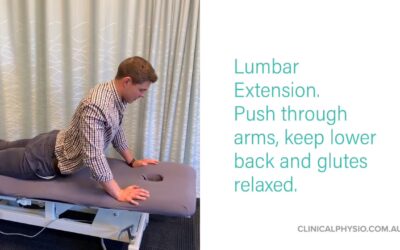Lower back pain is the single most common musculoskeletal complaint in the world. Up to 85% of the population will complain of low back pain at some stage in their lives. It is also the 3rd most common reason people will visit a GP.
Lower back pain can be broken into 2 broad types.
- Central Low Back Pain – pain that does not dominate one side and is experienced generally across the entire lower back region.
- Unilateral Low Back Pain – pain that is experienced on one side only.
It is this second that we are going to talk about.
Whilst there are other possible causes of unilateral low back pain, the most common cause we see is actually the hip. The reason is that when we load the lower limbs in tasks such as getting out of a chair, walking, running, climbing stairs, this load is transferred from the ankle, through the knee, then to the hip and then finally the lower back. If the hip is not functioning optimally, this load will bypass the hip and be transferred straight into the lower back on the same side.
Because the hip has significant movement in all 3 planes (forwards, backwards, side to side and rotation) it plays a much more complex role than the ankle and knee which move predominantly in 2 and 1 planes respectively. Back pain on one side can also be attributed to the ankle or knee but these are less common causes.
What does the evidence say?
Sadeghisani and colleagues in 2015 conducted a review of all the published literature of hip range of motion and its relationship to low back pain. They concluded that hip range of motion testing, particularly hip internal rotation, should be a standard, routine part of an examination for patients with low back pain.
Eyvazov and colleagues in 2016 conducted a study on 28 patients booked in for a hip replacement found that their concomitant lower back pain was reduced by 50% after their surgery.
A study earlier this year by Prather and colleagues on 101 patients with low back pain found that those with positive hip examination findings (predominantly reduced hip flexion and internal rotation range of motion), had more pain and poorer function compared to those with normal hip findings.
Sorenson and collegues (2016) found that asymetrical performance of hip abduction (moving the leg out to the side) was a significant risk factor for people that get low back pain when standing.
How do we find out if your hip is the problem?
There are 2 parts to the assessment.
- Assessment of your lumbar movements in positions that you have reported to be a problem. For example if you get your pain during or after running, then we’ll get you on the treadmill to have a look at what happens around the hip when you run. If you get the pain simply getting out of a chair, then we’ll examine that movement. We will often find that due to reduced hip function, there are abnormal compensatory movements that occur in the lumber spine.
- Assessment of hip strength and range of motion on the same side. Often if the pain is related to the hip, there will be deficits in either strength or range of motion or both, on the same side as your pain. Studies show that the 2 most important movements to assess are hip flexion and hip internal rotation.
If you are suffering from lower back pain one one side then don’t be afraid to get in touch with us to have your hip checked out.
Book online at clinicalphysio.com.au
Or alternatively send us an email here and ask us a question.
- Ellison JB, Rose SJ, Sahrmann SA. Patterns of hip rotation range of motion: a comparison between healthy subjects and patients with low back pain. Phys Ther. 1990; 70(9): 537-541.
- Chesworth BM, Padfield BJ, Helewa A, et al. A comparison of hip mobility in patients with low back pain and matched healthy subjects. Physiotherapy Canada. 1994; 46: 267-74.
- Eyvazov K, Eyvazov B, Basar S, Nasto LA, Kanatli U. Effects of total hip arthroplasty on spinal sagittal alignment and static balance: a prospective study on 28 patients.Spine J. 2016 Nov;25(11):3615-3621. Epub 2016 Jul 15.
- Prather H, Cheng A, Steger-May K, Maheshwari V, Van Dillen L. Hip and Lumbar Spine Physical Examination Findings in People Presenting With Low Back Pain, With or Without Lower Extremity Pain.Orthop Sports Phys Ther. 2017 Mar;47(3):163-172. doi: 10.2519/jospt.2017.6567. Epub 2017 Feb 3.
- Sorensen CJ, Johnson MB, Norton BJ, Callaghan JP, Van Dillen LR. Asymmetry of lumbopelvic movement patterns during active hip abduction is a risk factor for low back pain development during standing.Mov Sci. 2016 Dec;50:38-46. doi: 10.1016/j.humov.2016.10.003. Epub 2016 Oct 13.
- Sadeghisani M, Manshadi FD, Kalantari KK, Rahimi A, Namnik N, Karimi MT, Oskouei AE. Correlation between Hip Rotation Range-of-Motion Impairment and Low Back Pain. A Literature Review.Traumatol Rehabil. 2015 Oct;17(5):455-62. doi: 10.5604/15093492.1186813.

B.Sp.Ex.Sc.,M.Physio.,Cert.Spinal.Man.Tpy., APAM
Andrew Clark is a father of 3 and the owner and principal physiotherapist at Clinical Physiotherapy, St Ives. He graduated with a Masters degree from the University of Sydney in 2010 and has since had 10 years experience working in musculoskeletal private practice. He has undergone extensive professional development and has experience treating a wide variety of patients and musculoskeletal conditions.



